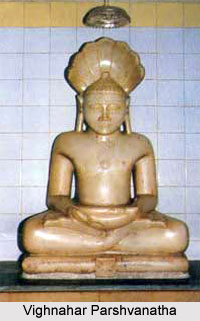 Vighnahar Parshvanatha Digambar Jain Temple is a Jain pilgrimage centre in Maharashtra. It is an Atishaya Kshetra i.e. place of miracles. Ashta is a city located in Sangli district in Maharashtra. Ashta dates back to the days of the British rule, from the year 1853. The principal deity of the temple is Lord Parshvanatha.
Vighnahar Parshvanatha Digambar Jain Temple is a Jain pilgrimage centre in Maharashtra. It is an Atishaya Kshetra i.e. place of miracles. Ashta is a city located in Sangli district in Maharashtra. Ashta dates back to the days of the British rule, from the year 1853. The principal deity of the temple is Lord Parshvanatha.
History of Vighnahar Parshvanatha Digambar Jain Temple
According to the history the temple is about 500 years old. This place has been named as `Ashta Kasar` after Kasar Jains. Earlier around 200-250 families of Kasar Jains resided here. During the rule of the Mughal Dynastythe idol of Lord Parshvanatha was moved to a safer place into a wooden box. However, a miraculous incident took place. The bullock cart carrying the idol suddenly stopped near Dustapur which is 2.5 km away from Ashta. After several efforts the cart did not moved forward. On that night the daughter in law of the village head saw a dream. In the dream she saw the lord refused to go anywhere and instructed her to reinstall him. The next day she narrated the dream to her family members. As per the instruction of the Lord the idol was brought back with great joy and devotion. A beautiful temple was constructed where the idol was installed with reverence. Since then this idol is being worshiped as the Village Lord.
Temple of Vighnahar Parshvanatha
The new temple of Vighnahar Parshvanatha has been built artistically with intricate designs. Earlier the temple was of `Hemadpanthi Style` whose remains can still be seen. The principal deity of the temple is Lord Parshvanatha. The idol is almost 1.5 feet in height and is seated in a padmasana posture. The idol is believed to have miraculous powers and has been installed in main altar of sanctum of the temple. Devotees get rid of their problems and difficulties after worshipping the idol hence it is known as "Vighnahar Parshvanath". It is a hoodless idol of Parshvanatha. As per the information present over the idol, this idol was reverenced in V.S. 1472. Two slabs having 24 idols each are also present in temple. The temple also houses idols of Bhagwan Rishabh Dev, Lord Suparshavnatha, Lord Chandraprabha and others.
Vighnahar Parshvanatha Digambar Jain Temple also organises various festivals and ceremonies. Every year an annual fair is organized on Chaitra Krishna for two days. Devotees and other people of nearby area participate in the annual fair. The temple has provision for dharmashalas or rest houses for the pilgrims that have been built in the upper part of this temple.
Vighnahar Parshvanatha Digambar Jain Temple can be reached via road. Buses and taxis are available from Osmanabad and Solapur. Ashta is linked with concrete road. The nearest railway station is Solapur Railway Station that is located at a distance of 60 km.




















